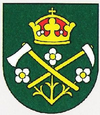Rejdová
| Rejdová | ||
|---|---|---|
| coat of arms | map | |

|
|
|
| Basic data | ||
| State : | Slovakia | |
| Kraj : | Košický kraj | |
| Okres : | Rožňava | |
| Region : | Gemer | |
| Area : | 50.518 km² | |
| Residents : | 761 (Dec. 31, 2019) | |
| Population density : | 15 inhabitants per km² | |
| Height : | 582 m nm | |
| Postal code : | 049 26 | |
| Telephone code : | 0 58 | |
| Geographic location : | 48 ° 47 ' N , 20 ° 17' E | |
| License plate : | RV | |
| Kód obce : | 526134 | |
| structure | ||
| Community type : | local community | |
| Administration (as of November 2018) | ||
| Mayor : | Slávka Krišťáková | |
| Address: | Obecný úrad Rejdová č. 47 049 26 Rejdová |
|
| Website: | www.rejdova.ocu.sk | |
| Statistics information on statistics.sk | ||
Rejdová (until 1927 Slovak "Radová", German Neuhaus or Neuhay , Hungarian Sajóréde - until 1907 Rédova ) is a municipality in the east of Slovakia , with a population of 761 (December 31, 2019), which for Okres Rožňava , a circle of Košický kraj heard.
geography
The municipality is located in the southeastern part of the Slovak Ore Mountains on the eastern slope of the highest mountain Stolica ( 1476 m nm ). The river Slaná has its source in the mountainous area of the municipality and it joins various streams here. The center of the village lies at an altitude of 582 m nm and is 11 kilometers from Dobšiná and 32 kilometers from Rožňava .
history
Rejdová was created at the beginning of the 16th century on the basis of Wallachian law and was first mentioned in writing in 1551 as Redowa . The place, however, arose on the site of two earlier lumberjack settlements. He belonged to the Bebek family and to the territory of the Krásna Hôrka castle . In 1672 Rejdová burned down after a Turkish attack and the plague from 1709 to 1710 killed 530 people. The population was and still is employed in mining, agriculture, forestry and alpine dairy.
population
Results after the 2001 census (738 inhabitants):
|
By ethnicity:
|
By religion:
|
Buildings
- Protestant church in Renaissance style from the 17th century
- preserved folk architecture from the 19th and early 20th centuries
